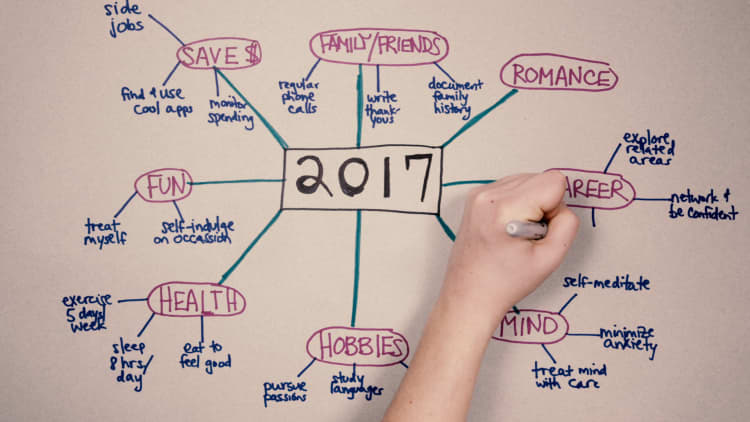Jenny Blake, a former career coach at Google, knows how to help people find happiness at work.
She's personally helped more than 1,000 people improve their work lives. One of the top strategies she recommends is to create a "mind map," or a visual diagram of your interests and goals.
Drawing one doesn't take long and could help you determine whether a new project, hobby or career change might make you happier and more successful, Blake says.
"My favorite way to brainstorm creatively, whether it's about values or setting goals for the new year, is through mind maps," Blake tells CNBC.
To make one, draw spokes with different themes that are important to you. For example, your spokes could be business, personal life, health and fitness, fun or skill building. From each of those themes, draw additional spokes connecting them to ways you want to improve or experiment in that area.
I made my own mind map, and here's what happened:
1. I realized that my personal goals help my career, too
Some goals that I put in my health and social categories have more to do with my happiness and success at work than I thought.
For example, my goal to visit one new place each month doesn't just help my social life. By visiting a new gallery, museum, or restaurant or attending a panel or event, I open myself up to meeting new people in different industries and social circles. Meeting new people could inspire a new project, partnership or give me general inspiration.
Even if I don't meet anyone, it's still worth it. Brian Wong, a 25-year-old CEO and founder, told me that simply being in new environments promotes creative thinking.
Another seemingly personal goal — preparing breakfast the night before — isn't just about eating better. It helps me get to work earlier and encourages me to eat foods linked to higher brain performance, such as nuts, fruit or eggs.
2. I needed to be specific (and realistic) in my goals
In the career section of my mind map, I could have written "be more organized," but honestly that wouldn't have done any good because it's so nebulous.
Instead, I remembered a technique that really helps me, which is to create a "To Do" list each morning so I know my top priorities.
I also could have written "be more productive" on my mind map, but again, without specific smaller goals, that objective would fall flat.
Instead, I realized that when I take a break during the day I'm more focused. So I wrote down a goal of taking a lunch break every day, even if it's for a short while. Simply getting outside of the office or eating away from your desk is proven to help clear your mind and give you time to do a few relaxation techniques.
3. Writing my goals in my calendar was the only way they were going to happen
According to psychologist Dan Ariely, who researches motivation, the best way to achieve your long-term goals is to break them into specific, smaller actions and record them in your calendar. The act of writing them down (or typing them out) every week helps you remind yourself of your long-term goals. It also breaks them into manageable parts.
For example, one of my goals is be smarter about my personal finances. So I took that huge task and broke it into parts.
I borrowed advice from 30-year-old self-made millionaire Kyle Taylor, who suggests that every professional take one day a week to review their spending, bank accounts and loans. He calls them "financial Sundays" — I took the idea and ran with it.
I'm going to hang my mind map up in my apartment and refer to it often. It reminds me of the full, exciting life I already have, and all the ways I plan to improve.
Check out a simple strategy one young millionaire recommends for getting smarter about your money.







